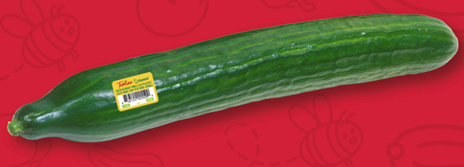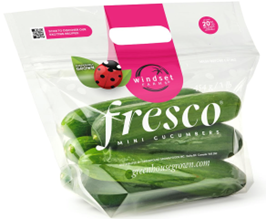The following actions, individually or collectively, will contribute to achieving the outcomes of reducing the environmental impacts of flexible packaging thru elimination and minimization.
Available Courses of Action
- Action 1 – Direct Elimination re Selling product loose (for produce packaging)
- Action 2 – Innovative Elimination
- Action 3 – Packaging Minimization
Action 1 – Direct Elimination (i.e., Selling product loose for produce packaging)
Offering product loose provides an important but challenging opportunity to reduce the environmental impact of packaging. Balancing the reduced environmental impacts of packaging against the impacts of distribution, sale and use of product, while meeting quality expectations, remains a key challenge.
The following use case(s) provide examples of where elimination has been demonstrated.
Use Cases
| Use Case | Innovation | Application | Release to Market |
| Walmart | Sell Loose | Organic bananas, single bell peppers | 2019 |
| Image |  |
|||
| Project | Walmart | |||
| Brand(s) | Walmart Canada | Packaged Product(s) | Organic bananas, single bell peppers | |
| Market(s) | Canada | Release to Market(s) | 2019 | |
| Manufacturer | Material(s) | Removed plastic wrap | ||
| Summary |
|
|||
| References | https://www.walmartcanada.ca/sustainability#plastic | |||
Action 2 – Innovative Elimination
The innovative elimination of packaging involves displacing the current packaging with alternative technology which provides the benefits of packaging while not incurring any of the environmental impacts. Unlike substitution, which seeks to replace one form of packaging for another, innovative elimination achieves the benefits of current packaging while eliminating its environmental impacts.
The following use case(s) provide examples of where innovative elimination has been demonstrated.
Use Cases
| Use Case | Innovation | Application | Release to Market |
| Apeel | Plant-based Coating | English Cucumber (and other fruits and vegetables like lime, avocado) | 2022 |
| Image |  |
|||
| Project | Apeel | |||
| Brand(s) | Topline Farms | Packaged Product(s) | English Cucumber (and other fruits and vegetables like lime, avocado) | |
| Market(s) | North America, Europe | Release to Market(s) | 2022 | |
| Manufacturer | Apeel | Material(s) | Removed plastic wrap | |
| Summary |
|
|||
| References | 2022 CPMA podcast discusses Apeel | |||
Action 3 – Packaging Minimization
Packaging minimization involves reducing the packaging mass while maintaining the current level of packaging functionality. A common form of packaging minimization is light weighting – reducing portions and/or the entirety of the packaging mass.
The following use case(s) provide examples of where packaging minimization has been demonstrated.
Use Cases
| Use Case | Innovation | Application | Release to Market |
| Windset Farms | Hard-to-recycle multi-layer, multi-material flexible bag replaced by mono-layer, mono-material solution that uses at least 20% less material while providing the same function. | Bell Peppers, Sweet Pointed Peppers, Mini Peppers, Mini Cucumbers, Eggplants | 2021 |
| Image |  |
|||
| Project | Windset Farms | |||
| Brand(s) | Packaged Product(s) | Bell Peppers, Sweet Pointed Peppers, Mini Peppers, Mini Cucumbers, Eggplants | ||
| Market(s) | Canada, US | Release to Market(s) | 2021 | |
| Manufacturer | Pacty Flexible Packaging Solutions | Material(s) | Low-density polyethylene (LDPE) bag | |
| Summary | Performance testing included packer and key retailers: -ensuring sufficient material gauge, including for handle component -shake test -packing test -shelf -ife test by Quality Assurance (QA) team -evaluated for visual clarity/consistency from a marketing perspective Aim is for all eligible products to be offered in this format by April 2024 Complies with GDR#6: Increase Recycling Value in Flexible Consumer Packaging Follows Federal Trade Commission (FTC) Green Guides when applying the “at least 20% less plastic than our previous bag” claim. Complied with key retailer request to only run this on-pack claim for 6 months. Brand owner reports that the 20% reduction equates to approximately 108,000lbs of plastic per year. | |||
| References | (2012) Federal Trade Commission Green Guides: https://www.ftc.gov/sites/default/files/documents/federal_register_notices/guides-use-environmental-marketing-claims-green-guides/greenguidesfrn.pdf | |||
Supporting Resources
Useful resources to consider as you explore applying one or more of the above actions to flexible packaging include:
General Information
- Why “Elimination” Won’t Solve the Packaging Pollution Problem 2022
Flexible Packaging Association (FPA)Highlights that while some plastic packaging can be eliminated or reduced, most packaging plays the vitally important role of protecting and preserving the efficacy of products and eliminating food waste. And that shortsighted elimination policies will not solve the problem and, in many cases, will result in more environmental harm.
- Design for Recycled Content Guide 2019
Sustainable Packaging Coalition (SPC)The Guide provides information on the key considerations around recycled content and how to design packaging that incorporates recycled content in order to drive demand for recycled materials. The Guide shares insights from experienced users of recycled content across the packaging supply chain to illuminate the opportunities and best practices for using recycled content in packaging.
Selling Loose
- Pathway to Selling More Uncut Fresh Fruit and Vegetables Loose? 2023
WRAP, and UK Plastic PactThis study explores opportunities to reduce household food waste and single use plastic packaging in the UK, highlighting specific targets, timelines and next steps.